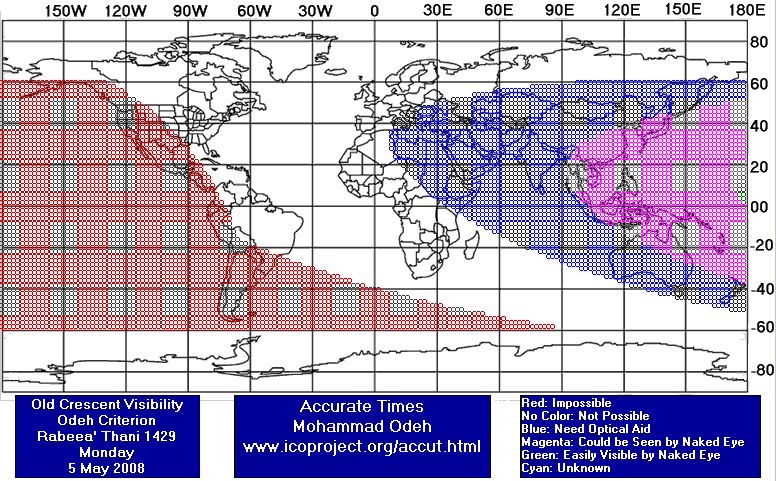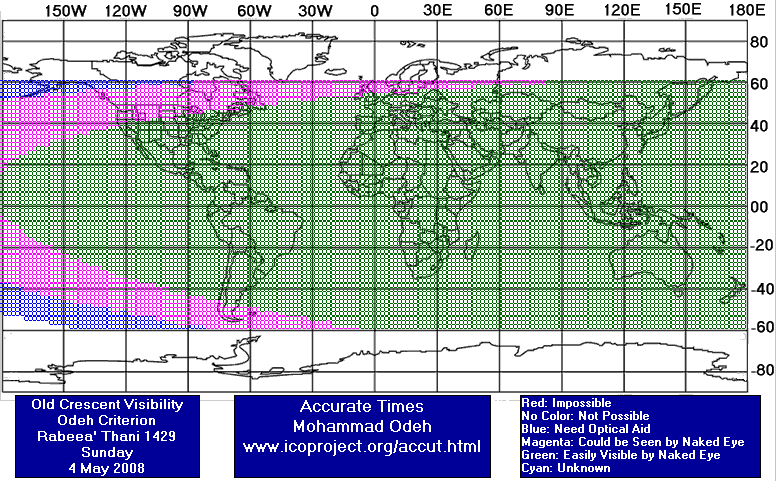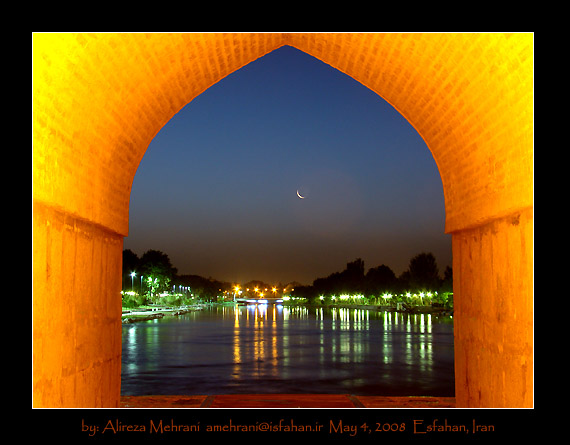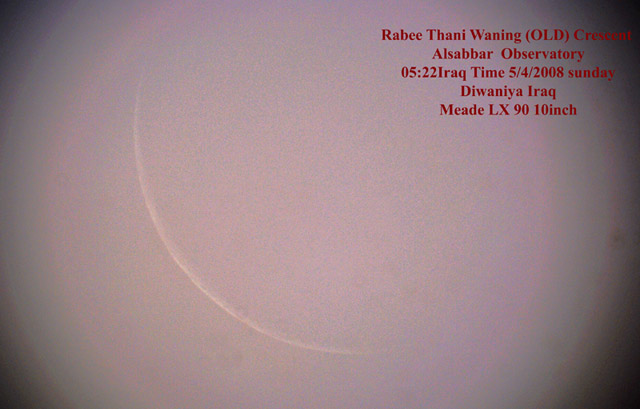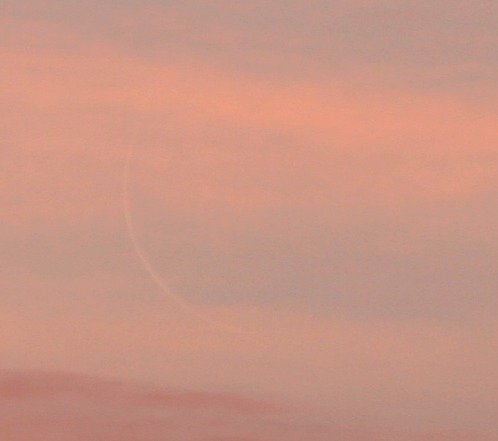Visibility of Jumadal Awwal Crescent
(1429 AH)
- When to Observe Jumadal Awwal Waxing (NEW) Crescent ?
- Jumadal Awwal Waxing (NEW) Crescent Observation Results
- The OFFICIAL First Day in Different Countries
- When to Observe Rabee Thani (OLD) Crescent ?
- Rabee Thani Waning (OLD) Crescent Observation Results
The geocentric conjunction (Geocentric New Moon) will occur Inshalla on (Monday 05 May 2008) at
12:18 UT.
Sighting the new crescent on (Monday 05 May 2008) and on (Tuesday 06 May 2008) is shown in the below graphs using the program Accurate Times by Mohammad Odeh according to Odeh criterion. Where:-
According to the Universal Hejric Calendar (UHC), which is based on the calculated crescent visibility, the start of this month in the Eastern Region will be on Tuesday 06 May 20088, and in the Western Region will be on Tuesday 06 May 2008 also.
- Results of seeing the crescent, and the first day of the month in different countries will be added here Inshalla as we receive the reports from ICOP's members. If you wish to be a member in ICOP, or to know more about it, kindly click here.
So far, the earliest sighting of the crescent -after sunset- was on Tuesday 06 May 2008 from Indonesia.
Monday 05 May 2008:
Tuesday 06 May 2008:
Observation report data:
Date: Tuesday May 6, 2008 (Ordibehesht 17, 1387)
Date: Tuesday May 6, 2008 (Ordibehesht 17, 1387)
Topocentric and local time values from "Moon Calculator" (Refrac off):
Crescent first observation through naked eyes by Mrs. Mir Shamshirgaran:
Photo: amehrani-NM-May2008.jpg
Tuesday 06 May 2008:
Wednesday 07 May 2008:
The geocentric conjunction (Geocentric New Moon) will occur Inshalla on (Monday 05 May 2008) at
12:18 UT.
Sighting the OLD crescent on (Monday 05 May 2008) and on (Sunday 04 May 2008) is shown in the below graph using the program Accurate Times by Mohammad Odeh according to Odeh criterion. Where:-
When to Observe Jumadal Awwal Waxing (NEW) Crescent ?
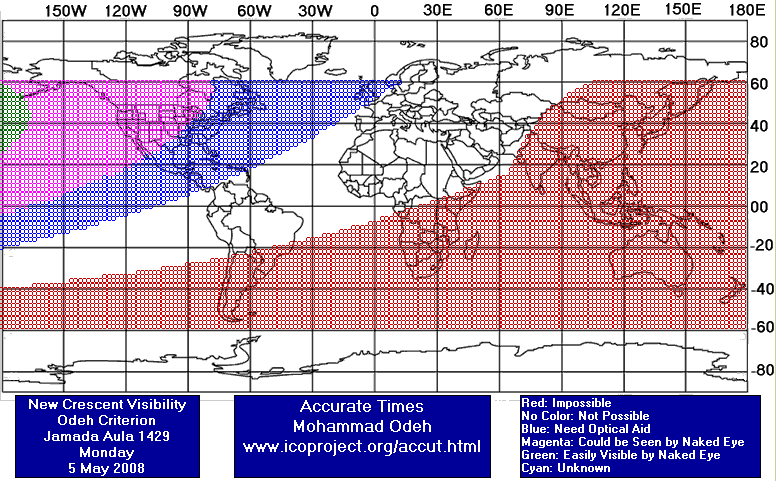
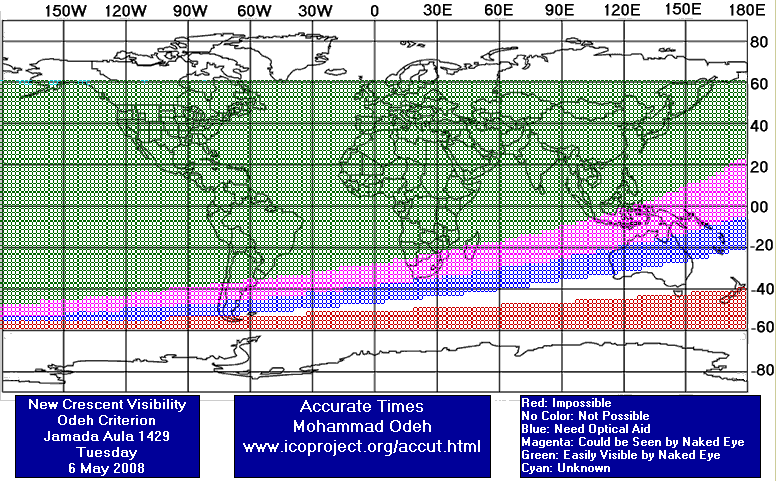

Jumadal Awwal Waxing (NEW) Crescent Observation Results
1. Maulana Mufti Habibullah + one scholar ("JAMIA-TUR-RASHEED", Ahsanabad, Karachi, Sindh. sky was polluted)
2. Maulana Waqqas + 3 ulama (Nazimabad 4, Karachi, Sindh. Sky 8 degrees polluted)
3. Maulana Mubashshir + some persons (Abbotabad, N.W.F.P. sky was partially cloudy)
4. Maulana Shaukat (Swabi, N.W.F.P. sky was cloudy)
5. Maulana Khushtar (Hyderabad, Sindh. sky was polluted.)
6. Major Nasir + one person (Karachi, Sindh. sky was polluted)
7. Maulana Abdul-Qahhar + one scholar (Pishin, Baluchistan. sky was cloudy)
8. Maulana Abdul-Hakeem (Texela, Punjab. sky was clear)
9. Maulana Shafee-ullah + some persons (Kohat, N.W.F.P. sky was cloudy and rainy.)"
Location : Gresik, Indonesia
Long/Lat : 112*37"24E / 7*10'11"S
Elevation : 120 meters
TZ : GMT+7
Sunset : 17:21 LT (calculation)
Moonset :19:06 LT (calculation)
Crescent first seen : 17:31 LT (observed) - Altitude: 6°7' (theodolit)
Crescent End seen : 17:39 LT (observed) - Altitude: 4°22' (theodolit)
Number observer : 20 persons"
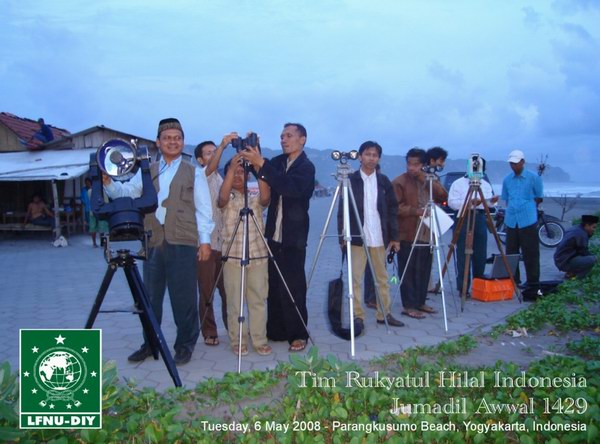
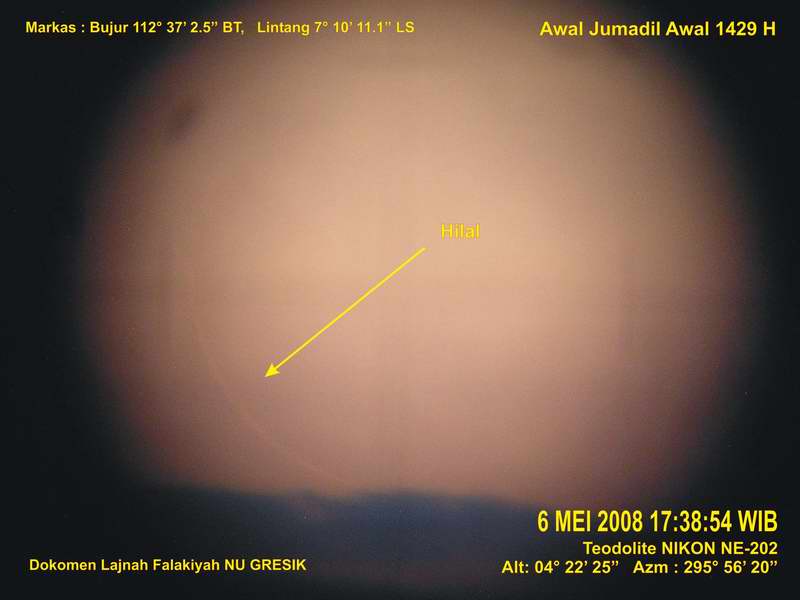
"On my request, today i.e. on May 6, 2008(Tuesday, 29 Rabee-uth-thani 1429 in Pakistan), many members of personal moon sighting committees of our institute "JAMIA-TUR-RASHEED" and my many friends tried to sight the moon all over the Pakistan and they easily sighted the moon, as it was expected tonight that moon could be easily sighted in Pakistan and mostly populated world. Reporters are as follows:
1. Maulana Noor Wahid Shah + one person (Madrasah Islamiah "a branch of JAMIA-TUR-RASHEED'' Battal, N.W.F.P. sky was partially cloudy.) He was the first person who reported me and the official moon sighting committee of Pakistan at 19:20 LT.
2. Maulana Abdul-Qahhar (Pishin, Baluchistan. sky was partially cloudy)
3. Maulana Abdul-Hakeem (Texela, Punjab. sky was clear)
4. Maulana Rustam + 2 persons (Hango, N.W.F.P. SKY was partially cloudy)
5. Maulana Faisal + Maulana Shahbaz + 20 ulama (Gaddi Bhit, Mitthi, Sindh, sky was very cloudy) Maulana Faisal sighted the moon first at 19:10 LT
6. Raees Khan + 8 people c/o molvi adnan shahzad (Swabi, N.W.F.P.)
7. Maulana Husain + many people (Charsaddah, N.W.F.P.)
8. Manzoor + Shaukat + Imtiaz c/o molvi Samee-ullah (Mansehrah, N.W.F.P.)
Note 1: I tried my best with 25 ulama and students to sight the moon in Nazimabad 4, Karachi Pakistan, but we could not sight due to very pollution and clouds. Many people tried in many places of Karachi but they could not sight the moon.
Note 2: Vice Chairman of central official moon sighting committee of Pakistan told me on my personal mobile number that he has received the positive reports of moon sighting from many cities of Pakistan; therefore he has officially announced that 1st Jumadal-oola 1429 will be on Wednesday, 7 May 2008 in Pakistan after ending the 29 days of Rabee-uth-thani 1429."
Location: Adib Astronomical Society, Esfahan, Iran
Latitude: 32° 37' 15" N
Longitude: 51° 40' 37" E
Elevation: 1597 meters from sea level
Time zone: +4.5
Observers: Alireza Mehrani, Mrs. Mir Shamshirgaran and other members of Mahtab Crescent Observation Group
Photographer: Alireza Mehrani
Optical tools: 15x70 binoculars & Digital camera (Sony DSC H9)
Sunset (calculated): 19:49 LT (15:19 UT)
Sunset (observed): 19:41 LT (15:11 UT)
Temperature: +22 C°
Barometer: 838.5 mb
Visibility: 8 km
Wind: 14.4 km/h
Crescent first observation through 20x60 binoculars by Mr. Fakhkhar:
Time: 19:44 LT (15:14 UT)
Moon Alt: 15° 50' 30"
Sun Alt: - (0° 03' 25")
Elongation: 15° 47' 05"
Rel Azi: - (0° 03' 17")
Moon Width: 0.63'
Moon Phase: 2.13%
Moon Age: 26h 56m after conjunction
Time: 19:48 LT (15:18 UT)
Moon Alt: 15° 05' 07"
Sun Alt: - (0° 43' 58")
Time: 20:23 LT (15:53 UT)
Moon Alt: 8° 34' 31"
Sun Alt: - (7° 30' 49")
Elongation: 16° 07' 40"
Rel Azi: - (1° 07' 20")
Moon Width: 0.66'
Moon Phase: 2.23%
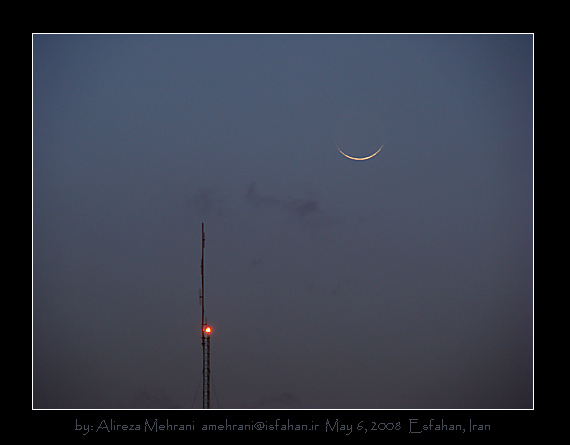
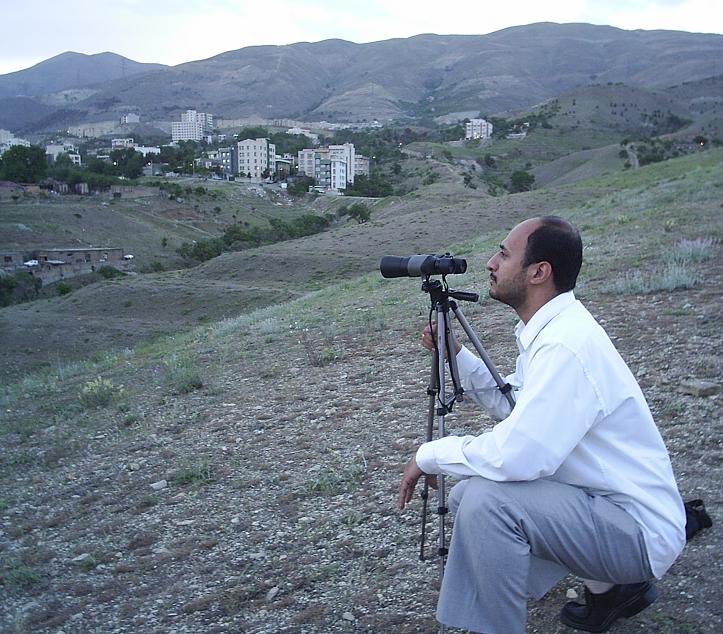
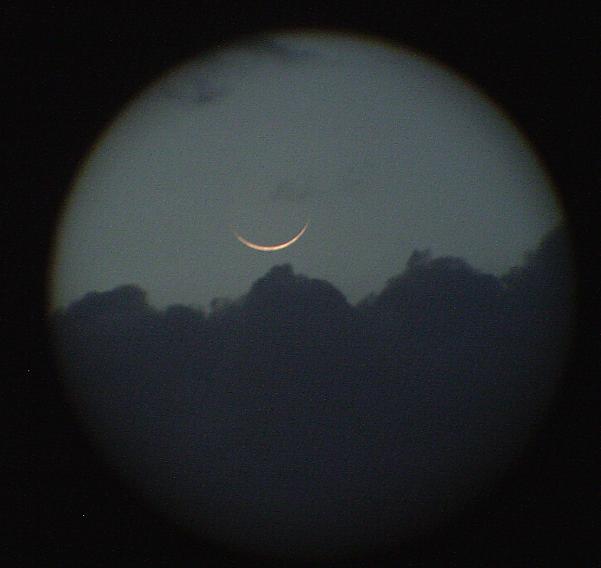
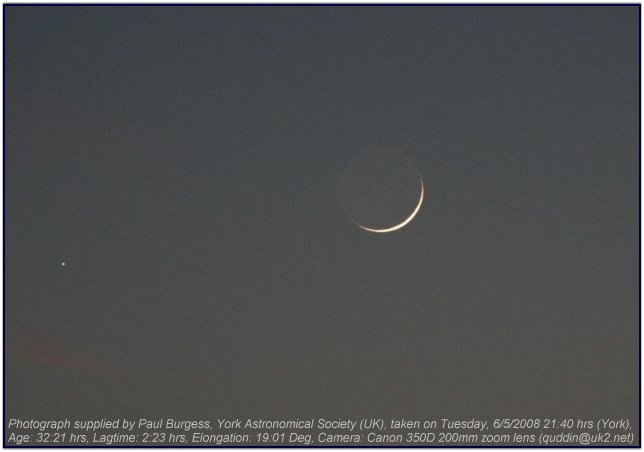
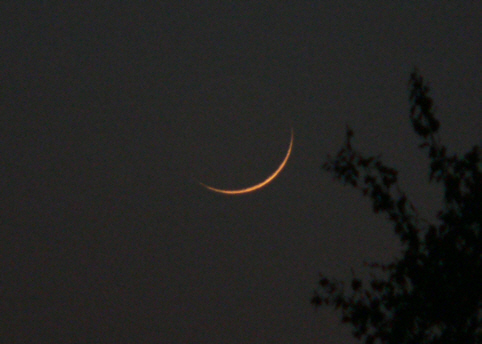

The OFFICIAL First Day in Different Countries

When to Observe Rabee Thani Waning (OLD) Crescent ?
